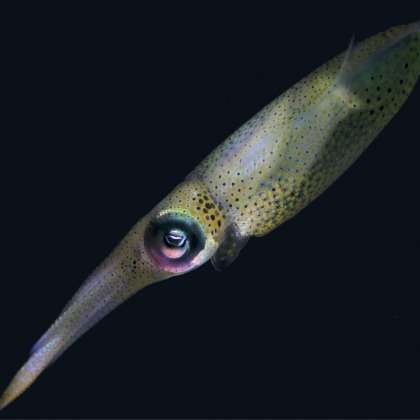Researchers discover how squid perceive distance

(Phys.org) —Researchers at The University of Queensland have discovered how a species of squid perceives distance, providing an evolutionary solution to a problem divers regularly encounter in featureless waters.
Scientists from UQ's Queensland Brain Institute studied how Sepioteuthis lessoniana, more commonly known as the bigfin reef squid, overcome blurred vision due to a retinal bump caused by their brains pushing against their eyes.
PhD student Wen-Sung Chung discovered that the squid use a characteristic bobbing motion to balance-out their visual impairment and precisely target prey.
"This remarkable range-finding mechanism allows for hunting, defence, and object size identification in an environment where depth perception is otherwise very difficult," Mr Chung said.
"When Dory the blue surgeonfish first saw the whale in the movie Finding Nemo, she was confused by its distance in the featureless mid-water world of the open ocean.
"She assumed the whale was small and nearby, rather than huge and far away.
"This is exactly the problem that the unusual optics of squid eyes has solved," he said.
"The tools for distance judgment that animals use on land are of no use at any distance underwater, even in the clearest waters.
"This new proposed range-finding mechanism in squid could help Dory to resolve this," he said.
The soft body of the squid can be easily deformed during catching and handling, meaning observations of the distorted eye were previously overlooked.
To prove the retinal bumps were not the result of post-mortem damage from capture, non-invasive methods including a miniature high-resolution ultrasound scanner were applied to investigate an intact specimen.
Mr Chung also built a device for infra-red retinoscopy, to observe the eye shape of free-swimming squid.
It took a year to develop a subtle range-finding model in which image blur can be used for coding distance to guide squid to enter the strike zone where their tentacles can reach.
"This discovery is another case of 'matched filtering', where animals only need a simple cue to know when and where to strike, without complex neural computation," Mr Chung said.
This is particularly important for invertebrates, most of which do not have a big enough brain to deal with something complex.
Japanese researchers are using a similar concept to design a new form of robotic vision using a sweeping sensor, similar to the squid's head bobbing mechanism.
"After we made this discovery, we studied other species and found that six others – another squid and five types of cuttlefish – also show retinal bumps," Mr Chung said said.
The retinal bump has not been found in any deep sea squid studied so far, illustrating that the range of light conditions at different depths drives squid to develop different eye designs.
The results of the research, which was funded by the Australian Research Council and the Asian Office of Aerospace Research and Development, are published in the journal Current Biology on 21 January 2014.
More information: "Range-finding in squid using retinal deformation and image blur." Wen-Sung Chung, Justin Marshall. Current Biology - 20 January 2014 (Vol. 24, Issue 2, pp. R64-R65). DOI: 10.1016/j.cub.2013.11.058
Journal information: Current Biology , Development
Provided by University of Queensland


















